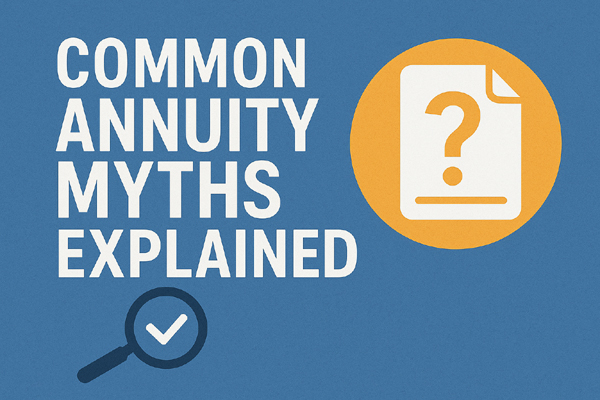Separating Fact from Fiction: Common Annuity Myths Explained

When evaluating retirement annuity options, many Americans encounter a maze of misconceptions that can cloud their judgment. From concerns about high fees to fears about losing access to funds, annuity myths persist across financial conversations. Understanding the truth behind these misconceptions is crucial for making informed decisions about your retirement security.
Let’s examine the most common annuity myths and separate fact from fiction to help you navigate this important financial decision.
Myth 1: All Annuities Are Expensive and Full of Hidden Fees
One of the most persistent myths suggests that annuities drain your savings through excessive fees. While some variable annuities do carry higher costs due to investment management and rider features, many fixed and indexed annuities offer competitive fee structures.
When researching specific products, such as reading a Gainbridge annuity review, you’ll discover that multi-year guarantee annuities often have minimal fees compared to actively managed investment accounts. These products focus on providing predictable returns rather than complex fee structures.
The key is understanding what you’re paying for. Administrative fees, mortality charges, and rider costs should be clearly disclosed. Products like the Athene Agility 10 demonstrate how fixed indexed annuities can offer growth potential with reasonable fee structures, making them accessible to middle-income retirees.
Myth 2: Your Money Gets Locked Away Forever
Perhaps the most damaging myth suggests that annuity purchases trap your money indefinitely. In reality, most annuities include withdrawal provisions that allow access to your funds, though timing and penalties vary by contract.
Surrender charges typically decrease over time, often disappearing entirely after 7-10 years. Many contracts also allow annual withdrawals of 10% or more without penalties after the first year. Emergency provisions for nursing home care, terminal illness, or unemployment often waive surrender charges entirely.
Modern annuity products have evolved to address liquidity concerns. When conducting a
Prudential annuity review, you’ll find that many variable annuities now offer flexible withdrawal options and living benefits that provide access during various life circumstances.
Myth 3: Annuities Don’t Provide Real Growth
Critics often claim annuities offer poor returns compared to direct market investments. This oversimplifies the diverse annuity landscape available today. While traditional fixed annuities provide modest but guaranteed returns, indexed and variable annuities can participate in market growth.
Fixed indexed annuities like the Athene Agility 10 link returns to market indexes while protecting principal from losses. This structure allows participation in bull markets while avoiding the devastation of bear markets—a crucial feature for retirees who lack time to recover from significant losses.
Variable annuities go further by offering direct investment in mutual fund-like portfolios. The trade-off for growth potential includes market risk, but many products include income riders that guarantee minimum withdrawal amounts regardless of market performance.
Myth 4: Insurance Companies Keep Your Money When You Die
A persistent fear revolves around the belief that insurance companies profit from early deaths by keeping annuity balances. This misconception ignores the beneficiary provisions built into virtually all annuity contracts.
Most annuities allow you to designate beneficiaries who receive remaining account values upon your death. Some products even offer enhanced death benefits that guarantee minimum amounts to heirs. The Canvas annuity program, for example, emphasizes transparent beneficiary provisions and flexible payout options for heirs.
Only immediate annuities with life-only payout options might not provide survivor benefits, but these represent a small fraction of annuity sales and are chosen specifically for maximum income during the annuitant’s lifetime.
Myth 5: Annuities Are Only for Conservative, Risk-Averse Investors
Many believe annuities only suit ultra-conservative investors afraid of any market exposure. This myth ignores the spectrum of risk levels available across different annuity types.
While fixed annuities do appeal to conservative investors seeking predictable returns, variable annuities can accommodate aggressive growth strategies through equity investments. Fixed indexed annuities occupy the middle ground, offering market participation with downside protection.
The real value lies in how annuities complement other retirement investments. Even aggressive investors may benefit from having a portion of their portfolio guaranteed through annuities, creating a floor of income security that allows more aggressive investing with remaining assets.
Myth 6: You Can’t Understand Annuity Contracts
Complex contract language intimidates many potential annuity buyers, leading to the belief that products are deliberately confusing. While annuity contracts do contain detailed terms, the core features and benefits can be understood with proper explanation.
Reputable insurers and advisors provide clear summaries highlighting key features like surrender schedules, withdrawal provisions, and benefit calculations. When evaluating retirement annuity options, focus on understanding the fundamental structure rather than getting lost in legal language.
Independent resources help clarify complex products. Comprehensive reviews break down contract terms into understandable language, helping you compare features across different insurers and product types.
Making Informed Decisions About Annuities
Understanding these myths helps you approach annuity decisions with accurate information rather than fear-based misconceptions. Annuities serve specific purposes in retirement planning: providing guaranteed income, protecting against longevity risk, and offering tax-deferred growth.
The key is matching annuity features to your specific needs and circumstances. Conservative investors might prefer the predictability of fixed annuities, while those seeking growth potential might explore indexed or variable options. Your timeline, risk tolerance, and overall financial picture should guide these decisions.
When evaluating specific products, thorough research is essential. Reading detailed reviews, understanding fee structures, and comparing features across multiple insurers helps ensure you select appropriate products for your situation.
Ready to separate fact from fiction in your own annuity research? Visit Annuity Gator for comprehensive, independent reviews of leading annuity products. Whether you’re exploring fixed, indexed, or variable annuities, making informed decisions starts with understanding the facts rather than accepting common myths.
Follow – https://financialapple.com for More Updates




